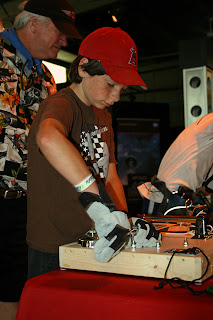 Aviation enthusiasts seek out certain destinations. There are Paris and Farnborough for the big international crowd, Kill Devil Hills, N.C. for the historians and Oshkosh, Wisc., for those who crave a look at aircraft that are a little different.
Aviation enthusiasts seek out certain destinations. There are Paris and Farnborough for the big international crowd, Kill Devil Hills, N.C. for the historians and Oshkosh, Wisc., for those who crave a look at aircraft that are a little different.For a week every summer a small airfield in central Wisconsin is an aviator's dream world. It's been that way for more than half a century, since what is now called EAA AirVenture started as a way to celebrate men and women who fly experimental aircraft.
It's grown so much since 1953 that Wittman Regional Airport, the home of the Experimental Aircraft Association, becomes the busiest airport in the country for that week according to the Federal Aviation Administration. That's pretty amazing since it normally doesn't even have scheduled airline service.
 Among the aircraft expected to fly into the airfield this year will be a research aircraft from NASA's Dryden Flight Research Center in Edwards Air Force Base, Calif. A NASA Gulfstream III aircraft will land at EAA AirVenture and be parked for public viewing at Aeroshell Square, perhaps not far from a huge Airbus 380 or Virgin Galactic's WhiteKnightTwo spacecraft. The G-III serves as multi-role testbed for a variety of flight research experiments. The aircraft's pilot will be available to answer questions.
Among the aircraft expected to fly into the airfield this year will be a research aircraft from NASA's Dryden Flight Research Center in Edwards Air Force Base, Calif. A NASA Gulfstream III aircraft will land at EAA AirVenture and be parked for public viewing at Aeroshell Square, perhaps not far from a huge Airbus 380 or Virgin Galactic's WhiteKnightTwo spacecraft. The G-III serves as multi-role testbed for a variety of flight research experiments. The aircraft's pilot will be available to answer questions.And they aren't the only NASA researchers and engineers who will talk to members of the public at the air show about everything from uncrewed air vehicles, past and future moon missions to how the space shuttle flies.
This year marks a special anniversary for NASA and the rest of the world — 40 years since humans first walked on the moon. To commemorate the occasion visitors to EAA AirVenture will be able to see a piece of the lunar surface in person. A moon rock picked up by astronaut Edgar Mitchell in 1971 during the Apollo XIV mission is a star attraction at the NASA pavilion.
This year we're celebrating not only our historic landing on the moon 40 years ago, but looking forward to the next generation of moon missions," said Jim Hull, NASA exhibits manager. "Last month we launched the Lunar Reconnaissance Orbiter. It's circling the moon right now, transmitting images. Then this fall the Lunar Crater Observation and Sensing Satellite will impact the moon looking for water ice."
The Oshkosh exhibit reflects the country's plans to return to the moon. Outside the building are two huge inflatables that represent a lunar habitat concept and the Orion crew capsule. Inside visitors can learn more about robotic moon missions and the systems that will rocket astronauts to the lunar surface from engineers from the Marshall Space Flight Center in Huntsville, Ala.
From the moon, air show participants are able to move onto Mars and a full-scale replica of one of the Mars Exploration Rovers in front of a three-dimensional Martian landscape.
No NASA presentation at an air show is complete without a look at NASA's contributions to aeronautics. Not only do exhibits feature a number of NASA-developed aviation technologies that are now common in airplanes, a special education area allows youngsters to make and take their own ring wing gliders and offer other hands-on activities.
But by far one of the most popular stops at the NASA building is the area known as the NASA craftsmen. Technicians from NASA's Glenn Research Center in Cleveland and Langley Research center in Hampton, Va., show off some of the models and tools researchers use to advance aerospace design.




No comments:
Post a Comment